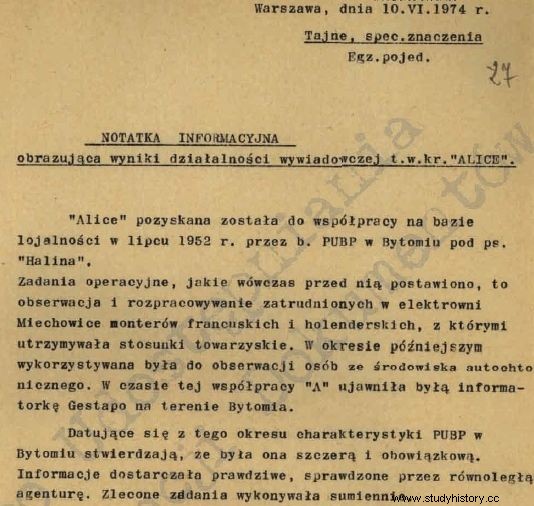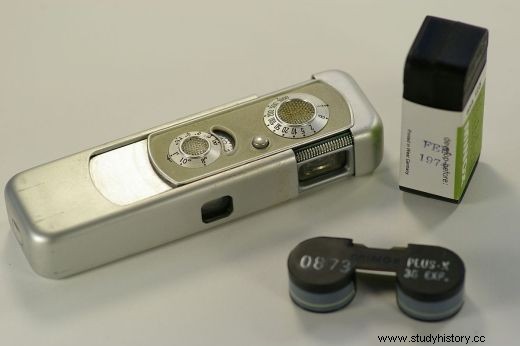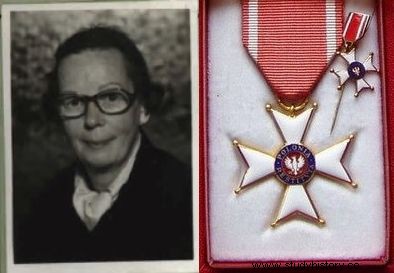She was a full-blooded German, a deeply religious person, apparently she hated falsehood and hypocrisy. After the war, for reasons only known to her, she became an intelligence agent. However, she did not spy for any of the new German states. Unlike her famous colleagues, she never got worked out, much less caught. This is the real ace of Polish intelligence.
Alice Kraffczyk was born into a family of Silesian Germans from the mining company Beuthen (today Bytom) in 1925. She was the second child of Helena and Walter Kraffczyk. Her peaceful childhood was not even interrupted by the outbreak of the war - after all, the Germans were winning.
At the age of eighteen, Alice was called to work as a nursing assistant in the military medical service in Breslau (Wrocław). However, as the eastern front was dangerously approaching Silesia, hard times had come for the Alice family. She made the difficult decision to stay in the besieged city, and when it got really dangerous - she broke through the line of Soviet troops, forests and the Sudetes to the Czech Republic. She was very lucky. It didn't fall into Soviet hands.

Childhood in Bytom, Germany, service in Festung Breslau ... Nothing indicated that Alice would connect her future with Poland.
She betrayed the Third Reich
After the end of the war, Alice did not go to Germany. She asked the Polish Repatriation Mission in Munich for permission to return to her hometown - now Bytom. It was not easy for her:she did not know the language, she could not find a job despite her qualifications. She made a surprising decision - she decided to become a spy in the services of the Polish People's Republic.

The story of Alice Kraffczyk was discovered and described for the first time by two historians of the Warsaw Institute of National Remembrance:Władysław Bułhak and Patryk Pleskot. You will learn more about her life, as well as the profiles of a number of other agents by reading their new book. "Spies of the People's Republic of Poland" has just been released by the Znak Horyzont publishing house.
In 1952 she established a secret cooperation with the County Public Security Office in Bytom and she became "Halina" with Alice. As an undercover agent, she investigated foreign specialists employed in the power plant in Miechowice and also infiltrated the environment of the Bytom Germans. The superiors were pleased with her, describing the agent "Halina" as sincere and obligatory . However, Alice's real career was just taking off.
Nice bird
Only five years after starting cooperation with the UB in Bytom, news about the prospective agent reached Warsaw itself. Department I, the intelligence division of the Ministry of the Interior, decided to take Alice and throw her across the border.
The occasion was perfect because it could be done as part of the German family reunification. In the same year, Alice and her parents joined her brother, Günther, who lives in West Germany. And when she managed to find a job at the Air Force Staff of the Ministry of Defense of the Federal Republic of Germany, which was reborn like a Phoenix from the ashes of the Luftwaffe, Polish intelligence could say that he had grabbed God by the legs.

Secret interview note about Alice Kraffczyk.
Agile and committed
Superiors melted in admiration for the efficient and committed agent, they could not praise her ingenuity, diligence, courage and dedication to the service. Lieutenant Colonel Roman Medyński, Alice's lead officer, wrote with admiration in a secret report, which was reached by Waldemar Bułhak and Patryk Pleskot, authors of the book "Spies of the People's Republic of Poland" :
She provided us with materials on the organizational structure and staffing of individual departments of the NRF aviation staff, its activities, foreign bases, air equipment along with technical data, electronic devices installed on particular types of aircraft , repair bases deployed in both the German Federal Republic and NATO countries, the deployment of radar stations, etc.
Then Alice started working in the Secretariat of the Bundeswehr's Parliamentary Plenipotentiary, from where she also reported to the Polish Ministry of the Interior. Her methods of work included copying documents, photographing them with the iconic Minox, preparing secret reports or microfilms. She never came by.
This article has more than one page. Please select another one below to continue reading.Attention! You are not on the first page of the article. If you want to read from the beginning click here.
Fortunately, we're all discreet

Alice Kraffczyk. The only surviving photograph from her youth. Material from the files of the Institute of National Remembrance.
In November 1973, on the orders of her superiors, Alice first moved to the German Ministry of Foreign Affairs in Bonn, and then started working as a secretary and translator at the Consular Department of the German Embassy in Warsaw. Such a loop in her biography led to a certain paradox: the new embassy clerk began to be investigated by ... Polish counterintelligence, unaware of anything .
Department II learned that Alice had previously worked in the Bonn Ministry of Defense and was now about to work in the military attachate, so connections with German secret services were suspected. Counterintelligence agents did not even realize that they were wasting time investigating a colleague, and their intelligence colleagues were laughing at them on the side.
After two searches at the MDM hotel where Alice lived, agents found nothing but underwear (the reports included a note about "high aesthetic taste") and two prayer books in Polish and German (as many as five copies were made in the hope that they were used to encrypt data).

Minox. Such a device was available to every self-respecting socialist spy. Also Alice (photo:Hustvedt; license CC ASA 3.0).
Counterintelligence agents not only did not provide any evidence of Alice's cooperation with the German secret services, but also that she was cooperating with the PRL intelligence services. Her reputation as a cautious and talented spy was well-earned.

The story of Alice Kraffczyk was discovered and described for the first time by two historians of the Warsaw Institute of National Remembrance:Władysław Bułhak and Patryk Pleskot. You will learn more about her life, as well as the profiles of a number of other agents by reading their new book. "Spies of the People's Republic of Poland" has just been released by the Znak Horyzont publishing house.
Maybe it would be nice to think about your own skin
In 1974, Alice was 49 years old and had two decades of espionage behind her. It affected her health - both physically and mentally. She was nervous, exhausted, tired.
It's time to retire. The deputy chief of Department I, Colonel Leszek Guzik, called for a faithful and distinguished spy. He sent a letter to the deputy minister of the Ministry of the Interior, Milewski, in which he emphasized the loyalty of the agent towards Poland and wrote that she devoted her entire life to the intelligence service.
He emphasized that the interview was for her "the only haven ”Because there is no family other than her brother who lives abroad, and therefore securing Alice's future is a moral duty of intelligence. He asked to settle the matter of the agent's remuneration and to award her for her work so far. This touching story apparently shattered the stony heart of Minister Milewski, because Col. Guzik's application was accepted, and Alice's application written shortly after it was considered in a flash.
She received a new legalization name, a fixed salary and a position in MO. But it is not everything. Already as a Polish senior sergeant, Halina Szymańska was awarded the highest Polish state decoration on December 4, 1974 - the Knight's Cross of the Order of Polonia Restituta. The justification read:

Alice (in the photo on the left) received the highest distinction of the Polish People's Republic.
Overcoming a number of difficulties, she managed to penetrate one of the most important, extremely well protected objects of the enemy. Working on this facility and carrying out intelligence tasks, she is exposed to constant risk.
Her work, conducted alone in a hostile environment, requires great fortitude, ideology, vigilance, self-denial, great conspiratorial skills and great mental and often physical effort [...].
The information she transmits is important for the political actions and defense of our country.
Source:
The article is based on the book by Władysław Bułhak and Patryk Pleskot entitled "Spies of the People's Republic of Poland (Horizon Mark 2014).
